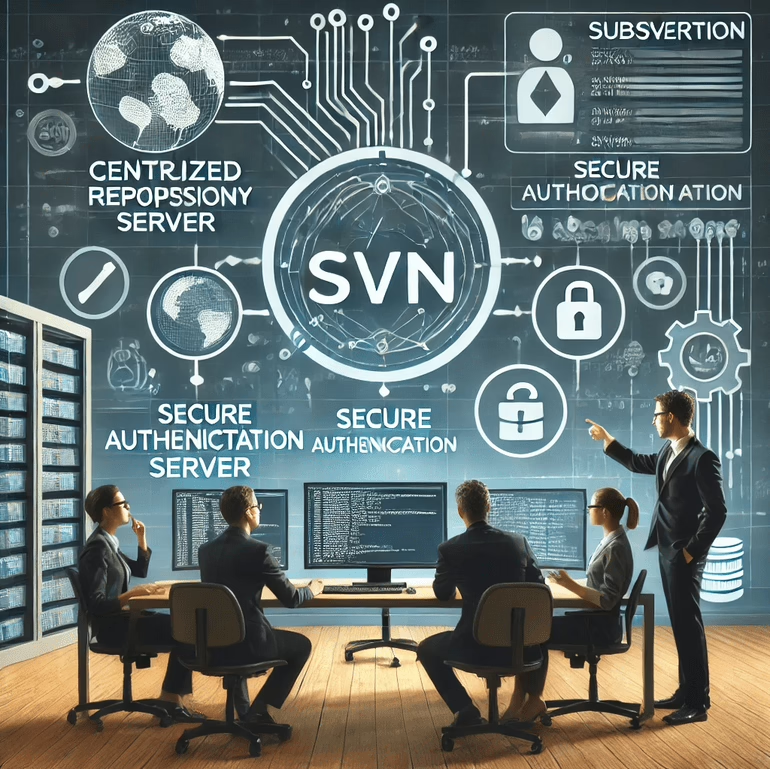Mastering Subversion (SVN):
Centralized Version Control for Modern Enterprises
In the fast-paced world of software development, effective version control is paramount to maintaining order and efficiency. Subversion (SVN), a centralized version control system (VCS), has been a cornerstone for many development teams, providing robust tools to manage changes, track progress, and collaborate seamlessly. While distributed version control systems (DVCS) like Git have surged in popularity, SVN remains a reliable choice, particularly for enterprises that prioritize centralized control and structured workflows. In this article, we will explore the key concepts and features of SVN, its advantages, and how Curate Consulting Services can assist in leveraging this technology to meet your organizational needs.
The Essence of Subversion (SVN)
Subversion, commonly known as SVN, is a centralized VCS used to track changes in files and directories over time. Unlike DVCS, which allow every developer to have a complete copy of the repository, SVN follows a centralized model with a single, master repository. This central repository stores the entire version history of the project, ensuring consistency and control.
Key Concepts and Features of Subversion
Centralized Repository: SVN’s centralized repository model ensures that there is one definitive source of truth. This repository contains the complete history of the project, and developers interact with this central hub to retrieve and commit changes. This approach is particularly beneficial for enterprises requiring tight control over their codebase.
Working Copy: Developers create a working copy by checking out code from the central repository. This local copy allows developers to make changes and test modifications independently before committing them back to the repository. This separation helps in maintaining the integrity of the main codebase while enabling individual experimentation.
Commit: Committing changes in SVN is an atomic operation, meaning all changes in a commit are applied together. This ensures consistency and prevents partial updates that could break the build. Each commit is assigned a unique revision number, allowing for precise tracking and rollback if necessary.
Branching and Tagging: SVN supports branching and tagging, providing a mechanism to create parallel lines of development. Branches are used for new features or bug fixes, while tags are often used to mark specific points in the project’s history, such as releases. This organizational structure facilitates better version management and easier integration of changes.
Merge: SVN includes tools for merging changes between branches. While the merging process might not be as sophisticated as in some DVCS, it allows developers to bring changes from one branch to another, ensuring that new developments can be integrated smoothly into the main codebase.
Revisions: Each commit in SVN is given a unique revision number, which serves as a snapshot of the project’s state at a specific point in time. This allows developers to track changes, identify the source of issues, and revert to previous versions if needed.
Access Control: SVN provides robust access control mechanisms to define who can read from or write to the repository. This feature is crucial for managing permissions and ensuring that only authorized users can make changes, enhancing security and accountability.
Authentication: SVN supports various authentication methods, including username/password, SSH, and SSL certificates. These options ensure secure access to the repository, protecting sensitive code from unauthorized access.
Integration with IDEs: SVN integrates seamlessly with many integrated development environments (IDEs) and code editors, providing developers with a smooth workflow. This integration allows for easy version control operations directly within the development environment.
Repository Browser: SVN includes a repository browser, enabling users to view the contents of the repository, explore revision history, and compare different revisions. This feature enhances visibility and helps in understanding the evolution of the codebase.
SVNserve and Apache Integration: SVNserve is a standalone server that serves SVN repositories over the SVN protocol. Additionally, SVN can be integrated with the Apache web server, offering a more feature-rich server environment. This flexibility in deployment options caters to various infrastructure needs.
Why Choose Subversion (SVN)?
Despite the rise of DVCS like Git, SVN remains a valuable tool for many enterprises. Here are some reasons why SVN might be the right choice for your organization:
Centralized Control: SVN’s centralized model is ideal for organizations that need strict control over their codebase. This centralized approach simplifies management and ensures that all changes are tracked in a single repository.
Simplicity: SVN’s straightforward model makes it easier for teams to understand and use. The concepts of commits, branches, and tags are intuitive, reducing the learning curve for new users.
Mature Ecosystem: SVN has been around for a long time, and its ecosystem is mature and stable. This stability is crucial for enterprises that rely on consistent performance and reliability.
Enterprise Adoption: Many large organizations continue to use SVN due to its reliability and ease of use. If your team is already familiar with SVN, it might make sense to continue using it rather than switching to a new system.
Curate Consulting Services: Your Partner in SVN Adoption
At Curate Consulting Services, we understand that choosing the right version control system is critical for the success of your development projects. Our expertise in SVN can help your organization harness the full potential of this powerful tool. Here’s how we can assist:
Implementation and Setup: We offer comprehensive support in setting up SVN repositories, configuring access controls, and integrating SVN with your existing development environment. Our team ensures that your SVN setup is optimized for performance and security.
Migration Services: If you are considering migrating from another version control system to SVN, we provide seamless migration services. Our experts handle the entire process, minimizing downtime and ensuring that your code history is preserved.
Training and Support: We provide training programs to help your team get up to speed with SVN. From basic operations to advanced features, our training sessions are tailored to meet your specific needs. Additionally, our ongoing support ensures that any issues are resolved promptly.
Customization and Integration: Every organization has unique requirements. We offer customization services to tailor SVN to your specific workflows and integrate it with other tools in your development pipeline.
Specialized Talent Acquisition: Finding the right talent to manage and utilize SVN effectively can be challenging. At Curate Consulting Services, we specialize in identifying and recruiting top-tier professionals with expertise in SVN and other version control systems. Our extensive network and rigorous vetting process ensure that you have the best talent to drive your projects forward.
Conclusion
Subversion (SVN) continues to be a robust and reliable version control system, particularly for enterprises that value centralized control and structured workflows. Its rich feature set, coupled with its ease of use, makes it a viable choice for many development teams. At Curate Consulting Services, we are committed to helping you leverage SVN to its fullest potential, ensuring that your projects are managed efficiently and securely. Whether you need implementation support, training, or specialized talent, we are here to assist you every step of the way. Contact us today to learn more about how we can help you succeed with SVN.












